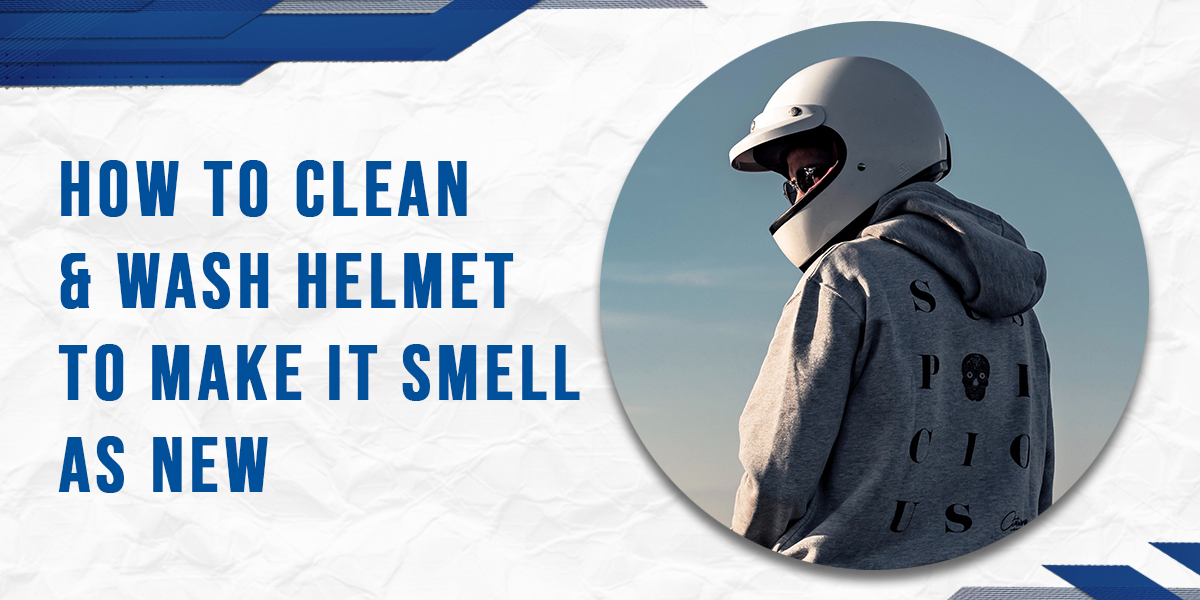Helmet is one of the most important biking accessories. A helmet is worn in all extreme climate conditions, be it rain or snow or sun, oh, don’t forget the dust.
It is true that the helmet protects you from all of the above. Though, the protection doesn’t come without a gradual downfall in the helmet’s fine condition.
The sweat formed inside the interior of the helmet adds stinkiness to it. Though, an unclean helmet may still protect your body but will damage your skin and hair.
Plus, who would love wearing a dirty helmet?
If you are wondering how to clean your helmet or how to wash it, you definitely shouldn’t skip this article.
What You Need
To clean your helmet, you can’t just use any material you get your hands on as it can worsen the helmet’s condition.
Here is a short check-list to help you in that regard.
- Warm water: Warm water is more effective in removing dirt. Don’t use hot water as that may damage the helmet’s lining. Keep it warm.
- Normal water: After a thorough wash with warm water, your helmet needs some pampering with normal water.
- Shampoo: A good smelling and deep cleansing shampoo will pay you in the end. Make sure the shampoo is not highly concentrated.
- Helmet cleaner solution: Products like this exist in the market but you need to get this if your shampoo choice is intended solely for fresh smell. If the chosen shampoo is good at cleaning, another exclusive helmet cleaner solution is not needed.
- Clean cloth: A clean cloth wipes out the dirt and can be reused for a new helmet cleaning session. You can use the cloth even after it resembles a rag as long as it is dirt-free. Cloth with more absorbency is ideal.
- Clean napkins: These better be moderately large as you’re gonna use it for initial and final touch. No rags here, though.
- Automotive wax: If you haven’t been using this, grab one from the stores as the benefits (which you’ll soon know) are sure to reduce your stress.
Your cleaning gear is set. But you cannot go to clean and rinse your helmet right away. If you dare to do it, be prepared for a half-clean helmet or some damage or a completely damaged helmet, in the worst case.
To prevent such disasters, you need to prepare your helmet for the thorough cleansing session it is going to be put through.
Disassemble Your Helmet
First, you have to disassemble your helmet. You don’t have to divide it part by part. Pay attention to the additional accessories that come along with your helmet. Remove all the internal sensors and other similar accessories your helmet is equipped with.
In some helmets, the whole helmet can be divided into two parts due to the presence of a separate top surface. Most of the helmets have a removable visor. So this must not be hard for you.
If you want to clean at a pro level, remove the inner lining too. This lets you clean the maximum possible surface of the helmet and to deep clean the inner lining which is prone to get stinky over usage.
Cleaning the Helmet’s Exterior
Grab a cloth and soak it in warm water mixed with shampoo. Wrap the dirty helmet with this wet cloth.
This will help the dirt stuck on the helmet’s surface to loosen up thus making your job easy.
Let it sit for 15 to 20 minutes.
Meanwhile, mix shampoo with warm water in a bowl. After 15 minutes of constantly wetting the helmet with that wrapped cloth, apply the shampoo solution to the helmet’s surface and rub gently.
After you are satisfied with your helmet’s new cleanliness, wipe it with a clean cotton napkin and let the helmet’s exterior surface dry. Keeping it wet for a long time will damage the coating.
Wipe it dry and let it get some air. Mark that it needs air but not heat. You don’t have to blow dry the clean helmet. Heat from the blow dryer is not your helmet’s best friend.
Clean the airflow vents with a clean cotton swab.
Bonus: If you have a compressed-air gun to clean, then blow the vents and joints. Compressed-air gun is easier on your hands and eyes than a cotton swab.
Cleaning The Helmet’s Interior
We’re done with the exterior shell of the helmet. For the interior side, the method varies.
You can wash the cheek pads in shampoo with your hands or you can put them for a quick wash in your washing machine (remember to turn off the option of drying).
For machine washing, use a mildly concentrated detergent. After you’re done washing, let them dry at room temperature. If the liner of your helmet is removable, wash it as well.
If not, add this step to the above cleaning section of the exterior shell.
Finish the cleaning of the remaining interior portion with the same method and let it dry.
Final Touch-Up
Time to assemble your helmet and make it ready for your next biking adventure.
Set your cheek pads and lining back in place. Additional accessories which you removed in the beginning will go in now.
The best way is to take a few snaps via your smartphone while disassembling the helmet so that they will be your guide later on.
Give a coating of automotive wax on the helmet’s surface so that the upcoming dirt and junk will get stuck on the wax but not the helmet making your next cleaning session easier.
Additionally, while cleaning next time, you only have to wipe the wax clean without paying any special attention to the dirt marks.
Sum-up on How to Keep Your Helmet Clean
What To Do
- Use a mildly concentrated detergent or a shampoo that has a good smell.
- Make sure the water is neither too hot nor too cold.
- Use a clean cloth (preferably cotton) in all phases of cleaning and drying.
- Disassemble the helmet so that the cleaning agent reaches unclean areas of the helmet. Most importantly, remove the visor before cleaning.
- Give a coating of automotive wax to protect the helmet’s surface from future dirt and junk.
- Wipe your helmet’s surface at the end of the day to remove dusts.
- Let the interior parts and the exterior shell dry well before bringing them together as one.
- Use a skull cap to prevent friction between your hair and the helmet’s interior. A bandanna will also do as well.
- Make sure your hair is clean so that it won’t accentuate the stinkiness in the helmet.
- Let your helmet get air everyday when you aren’t using it. For this you can flip it over such that the interior is exposed to air. Air helps in reducing the stink.
What Not To Do
- Soak your helmet into a tub of water and toss it inside out. There’s no easy way. Calm down!
- Scrub the visor with your bare hands or rough material. If you do, you will have to replace your visor with a new one every time you clean your helmet.
- Use a heavily concentrated cleaning agent believing it would have a fine cleaning effect. Nope! Heavy concentration only increases the damage without making any difference from the damage caused to the helmet by the harsh weather.
- Scratch the junk marks with your nails or a sharp knife or a similar sharp object.
- Blow air into the vents through your mouth. This is not hygienic as well.
- Squeeze the cheek pads competing with a dryer. You would be left with good for nothing cheek pads.
- Put your cheek pads in a dryer or use a few dryer sheets to make the drying job easy for them. A big no.
- Cleaning your helmet while it has all in-built accessories still installed. Why do you even buy a helmet with connectivity sensors when all you wanna do is destroy them?
- Try to remove the non-removable liner of your helmet. Argh! This is why they say read the instructions before you use (in this context, before you clean). Know what type your helmet is.
- Put the liner in the machine and then in the dryer.
Check out these instructions to clean your visor without blurring or scratching it.
How to Clean Helmet Visors (without getting them scratched)?
Visor is a delicate part of the helmet and visor’s quality determines your visibility while driving. You cannot afford to leave the visor dirty.
You have checked out how not to treat your visor in the “What Not To Do” section. If you are now thinking about ‘how to clean the visor’, without any further ado, let’s dig deep to know how to make your visor as good as a new one.
- Make a solution by pouring a few drops of gentle shampoo in lukewarm water.
- Apply this solution to the visor with a clean hand.
- Wipe it gently with a clean, soft cloth. The softer the cloth, the better.
- If the dirt marks are too stubborn let them soak for a while in the solution.
- Wipe them clean once they get loose.
Though it sounds simple, not overdoing anything is a vital caution particularly for the visor.
That’s it. You’re done. Indulge yourself in the comfort of the clean helmet and worry not about the next session as you now know what exactly you gotta do.

